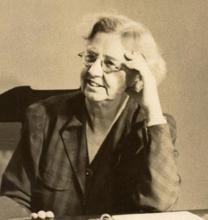
Caroline Pratt (1867-1954) was an innovative educator who as part of the progressive movement, Pratt developed teaching methods that focused on play as an alternative to what she felt was the “repression of formal education” of that time.1
Caroline Pratt grew up in the farming community of Fayetteville, New York. She taught first grade for five years from 1887 to 1892 in Fayetteville and then became interested in the growing kindergarten movement founded by Friedrich Froebel in Germany. The first English speaking kindergarten in America was established in 1860, and by 1880 the number had grown to 400. Pratt was influenced by Froebel’s kindergarten philosophy that suggested that children’s play and activity were central to their individual growth and development.2
Pratt’s early work in understanding the role of play in education began with her study at the Philadelphia Normal School and later, in 1901, the Hartley School at the Henry Street Settlement House in New York City. In 1914, Pratt opened her own school in Greenwich Village, New York, originally called the Play School and later renamed in 1919 as City and Country School.3
Her Play School was started in a three-room apartment that served the young neighborhood children from working class families. Her first students were four years in age and as the school became more widely accepted, older children up to the age of thirteen were gradually admitted. Her philosophy of teaching was based on the children’s interests, and through play she allowed them to learn experimentally through their experiences in their immediate environments.4
Pratt rejected the idea of a fixed curriculum and allowed children to freely choose their play projects. To stimulate curiosity, real world experiences through field trips were provided, and the classroom was filled with play materials and loose parts, such as blocks, paper, crayons, and clay. As the children reenacted pretend play scenarios from their observed experiences, they made sense of the world around them. Children were only introduced to subject matter as it emerged in their play as necessary. There was no formal subject matter instruction, no grading, and no set curriculum.5
She felt their social interactions were important to their learning and understanding of their place in the world. At the Play School children were given practical jobs that taught them to take responsibility for their tasks and to interact with others in the development of their school community. Pratt felt that grounding children in real world experiences would help them learn social truths in democracy and working together as a community.6
In 1916, Pratt along with Lucy Sprague Mitchell founded the Bureau of Educational Experiments (BEE). The organization was dedicated to the unbiased, scientific study of children’s nature and growth, and they used the Play School as their laboratory. Their study was strictly observational, with data compiled on the children’s daily activities, physical habits, and social relationships with each other. They also kept extensive records of children’s speech, physiological information, tests results of motor coordination, psychological testing, family histories, and personality tests. They worked together over ten years collecting some of the most detailed case studies of children done at that time.7
In the 1930s, Pratt’s school, now called City and Country School, collaborated with the New York public schools to start after school programs. This led to the adoption of Pratt’s school philosophy to several public school programs, and she was honored in The Nation magazine’s 1939 Roll of Honor with a citation that read: “Caroline Pratt, founder of the City and Country School. Whose devotion to the principles of progressive education won their acceptance in the organization of a number of public schools in New York State.”8
Pratt is credited for developing wooden blocks, called unit blocks. They were similar to the blocks used by Froebel based on the proportion of 1:2:4.9 The wooden unit blocks she developed for City and Country children ages two through seven were widely admired and copied.10 She also designed wooden figures of family and community workers she called “do-withs” to accompany the unit blocks. Pratt well documented the block work of children, which influenced the continued use of blocks through the years.11
As Pratt observed children deeply absorbed in block play, she noted, “In his play (he) was thinking, learning, setting down his understanding of the way things worked, the relationship of facts to each other…educating himself.”12 Because of her extensive work in block play, blocks continue to be used in classrooms today as essential tools for learning.
- 1. “History of City and Country School.” City and Country School. < http://cityandcountry.org/about-us/history/ > 30 Nov. 2011.
- 2. Hendry, Petra Munro. “Learning From Caroline Pratt.” Journal of the American Association for the Advancement of Curriculum Studies. Volume 4. February 2008. < http://www2.uwstout.edu/content/jaaacs/vol4/Hendry.pdf > 30 Nov. 2011.
- 3. Ibid.
- 4. Hoover, Stacey and Michelle Dupuis. “Progressivism.” The Lion’s Den. Southeastern Louisiana University. < http://lionsden.tec.selu.edu/~shoover/607/progressivepacket.htm > 30 Nov. 2011.
- 5. Op. cit., Hendry.
- 6. Op. cit., Hendry.
- 7. Op. cit., Hendry.
- 8. Hauser, Mary E. Learning from Children. The Life and Legacy of Caroline Pratt. New York, NY: Peter Lang Publishing. 2006. pp. 123-124.
- 9. “Caroline Pratt. wooden unit blocks.” Froebel Web. < http://www.froebelweb.org/web2027.html > 30 Nov. 2011.
- 10. Personal email from Jennifer Marck Moran of City and Country School to Playground Professionals. 11 Jan. 2012.
- 11. Hewitt, Karen. “Blocks As a Tool for Learning: Historical and Contemporary Perspectives.” Young Children. January 2001. NAEYC. < http://www.naeyc.org/files/yc/file/Hewitt0101.pdf > 30 Nov. 2011.
- 12. Pratt, Caroline. I Learn from Children. New York: Simon & Schuster. 1948. p. 29.

